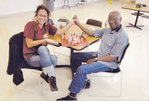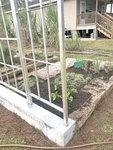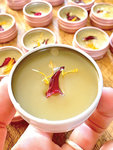



Picture a slender vine pushing through a cellblock and you have a good idea of jackie sumell’s mission in life. Her path was changed forever by a man who spent decades in solitary confinement and longed for gardens. (She prefers to spell her name in lower case.)
According to the Bureau of Justice Statistics, the United States has an $81 billion problem. It holds approximately 2.3 million people in custody, a community that rivals the population of Botswana but remains virtually invisible to the public eye.
Sumell, an herbalist and visiting artist at Michigan State University’s College of Arts and Letters, compared the search for alternatives to systems of punishment to growing a plant. By helping prisoners grow medicinal plants, she has found that green shoots can infiltrate the gray prison walls and, maybe, begin to crack them open.
Walls and gardens
The Prisoner’s Apothecary is a plant-based traveling pharmacy designed by prisoners.
It has teas containing lavender to help with insomnia, organic mosquito repellent and tinctures with passion flower. These plant-based substances come from 15 “Solitary Gardens” across the United States, a project of sumell’s that began in 2016 in New Orleans — where she has lived long enough to earn the title “auntie of the 7th Ward.”
Big things start small. A Kickstarter campaign, which ends Wednesday, Nov. 6, is calling for $25,000 to buy a retrofitted vehicle to make the apothecary mobile. The goal is to travel to herbalist conferences, or communities in need of medicine, to engage them in a conversation that begins with the natural healing qualities of plants — and ends with prison abolition.
The process of making medicine for the apothecary begins with a prisoner receiving a template for a Solitary Garden in the mail. The template is a bird’s-eye view of a 6-by-9-foot prison cell. Staring at the template’s white space, unoccupied by the bed, toilet, desk and chair, prisoners can let their minds roam and create a fantasy garden full of nutrients and rejuvenation. But this exercise is not just to help them escape from their cells mentally. They are making a blueprint for a space that, with time and care, could help heal the communities they’ve been accused of harming.
One of the apothecary’s most advanced garden architects is Warren “Chopper” Palmer, who studied horticulture while he was in solitary confinement for 10 years. He grows an organic mosquito repellent, planted a butterfly garden and built a “Complimentary Therapies” flower bed full of cantaloupe and passion flower. Palmer discovered that passion flower induces an acid in the brain that functions as an inhibitory neurotransmitter, thwarting anxiety and helping decrease opium withdrawal symptoms. Palmer will be up for parole next year.
The gardens connect incarcerated people with surrounding communities in an organic, healing way. The people maintaining the gardens and crafting the plant-based medicine are civilians who live in areas affected by mass incarceration. Volunteer workers — even celebrities like Colin Kaepernick and Susan Sarandon — dig and work the gardens, bringing the visions of prisoners to reality.
Freighted with symbolism yet grounded in fertile earth, the gardens are a fragment of sumell’s imaginary world, where mass incarceration is demolished, refusal to participate in the grammar of the patriarchy is the norm and inner-city children can purchase natural medicine with an EBT card. Sumell said that people from across the country reach out asking to get involved with Solitary Gardens and the Prisoner’s Apothecary.
“The next thing you know, they are becoming pen pals with people in solitary confinement and then from there maybe they are asking to grow a garden on behalf of that person, sort of rehumanizing through gardening,” sumell said.
#StopSolitary
Back in college, during the “1900s,” as she likes to say, sumell was a foot solider with environmental activists in San Francisco, but her first brush with activism actually started on Long Island, N.Y., when she was 13 years old and the one of first girls to play football in the United States.
“I know in hindsight, and through a lot of therapy, I did it to impress my dad, who was and is a misogynist,” sumell said.
As a child, to escape the harsh of realities of a violent household, sumell would consult with imaginary friends and dream up alternate scenarios — a superpower she wouldn’t fully recognize until her late 20s.
Sumell first got national acclaim in 2001 as an M.F.A. student at the San Francisco Art Institute. Her goal was to get 538 women — the number of certified votes by which George W. Bush won in Florida, plus one — to shave their pubic hair, put it in plastic bags and send it to her for a project entitled “No Bush!” That same year, she met Robert King, who at the time, was the only freed member of the Angola Three, three African-American prison inmates who were held for decades in solitary confinement.
King had walked out of the Louisiana State Penitentiary in 2001, where he spent 31 years, 29 of them in solitary confinement. King, Albert Woodfox and Herman Wallace were accused of murdering a prison guard. Shortly after being released, King traveled coast to coast to give lectures on his experience, mostly talking with artists, including sumell, who knew little about prison reform and mass incarceration back then.
In the talk, King explained how he was one of three political prisoners who got indefinite sentences in solitary confinement. King, Woodfox and Wallace met inside the plantation-turned-prison, and they started the first chapter of the Black Panther Party to be organized in a prison. The trio organized prisoners to end rape, taught them how to read and write and facilitated race relations.
“The House The Herman Built,” a book documenting sumell and Wallace’s friendship, tells the full story, from the first letter she sent him to the establishment of an internationally traveling exhibit in King’s honor.
Wallace was serving a prison sentence for armed robbery when a correctional officer, Brent Miller, was stabbed to death during an insurrection in Angola in April 1972. In 2011, the three men were subjects of Vadim Jean’s film “In the Land of the Free.” In the film, the widow of Miller said of the Angola Three, “If they did not do this — and I believe that they didn’t — they have been living a nightmare.”
How does one start a conversation with someone who has spent nearly 30 years in solitary confinement?
Sumell’s solution was characteristically inventive and personal. As a conceptual artist, she duct-taped a camera on one wrist and set her watch timer to beep every hour as she went about her day, reminding her to pause and take a picture of her surroundings.
“They were the kind of photos that most ‘free’ people would throw away as mistakes,” sumell wrote in the book. “I printed the photos and mailed them to Angola Penitentiary, 70712. The letters were formally addressed: ‘Dear Mr. Woodfox’ and ‘Dear Mr. Wallace, here are 24 hours in my simple life. I cannot imagine yours.’”
The prompt that drove the next 12 years and counting of sumell’s life came from an assignment from her professor to interview faculty about “spatial relationships and exorbitant dream homes.” Instead, she asked Wallace, “What sort of house does a man who has lived in a 6-foot-by-9-foot cell for over 30 years dream of?”
Escaping prison
The first thing Wallace asked for were gardens. He wanted his guests to be able to walk through gardens year-round. He asked for many windows, a library, a bathtub the size of his current cell and a pool with a mural of a black panther on its floor.
This conversation lasted for over a decade. Sumell spent most of her time converting Wallace’s handwritten instructions into models, virtual fly-throughs and renderings, while getting psychiatrists, architects, sociologists and law professors on board to raise awareness about Woodfox and Wallace’s unjust sentencing.
The art world couldn’t get enough of sumell. She has presented Herman’s dream home, and offshoot projects such as the Solitary Gardens, at over thirty venues in nine countries. The book caught the attention of a young filmmaker named Angad Bhalla, whose documentary “Herman’s House,” traced sumell’s creative process and won an Emmy in 2014 for Best News and Documentary.
PBS aired the documentary in August 2013. Sumell received a flood of requests from people around the world, collecting accolade after accolade — all while Wallace sat in his cell, deteriorating from liver cancer. In September 2013, sumell visited Wallace in prison hospice. He had stopped eating, his eyes were yellow with jaundice and he was barely conscious, said sumell.
“I said goodbye to Herman inside of a prison, breaking the promise that had fueled the last 12 years of my life: the promise that he would die free,” sumell wrote.
Wallace was released from prison Oct. 1, 2013. Three days later, he died. He was 71 years old and had served 44 years in prison, 41 of which he spent in Closed Cell Restricted, with one hour of outdoor recreation each day.
Cancel culture in the punishment capital
Woodfox and Wallace are two of sumell’s most revered elders. They helped her maintain perspective after the end of a messy four-year relationship, her mother’s death and the desolation of New Orleans by Hurricane Katrina.
“I was so mean for so long, and so unhappy,” she said. “Herman was like, your shit’s hard, Jackie. I just want to remind you I’m on my 30-something year of solitary confinement and I still love.”
Life didn’t make it easy for sumell to absorb his words. Years ago, she was sexually assaulted by a member of her organizing community. At that moment, she was forced to think about justice, not in abstract or general terms, but as a personal question.
“I still don’t want that person to go to prison for that,” she said. “I know that’s not the solution. But then, it’s like, do nothing and there’s no forced accountability.”
During the peak of the #metoo era, the online movement generated a trend of “canceling” individuals who are accused of rape, either calling for them to be removed from their jobs or simply rejecting from their social spheres. For sumell, this reaction isn’t a shock considering the society we live in.
She didn’t go into detail about how her situation was resolved. She said that survivors’ use of social media to out perpetrators ultimately causes more harm to the community. It presents a platform for the accused to show evidence, such as revealing texts, to argue their innocence and pushes members of a community to take sides.
“So what are we doing to organize communities preemptively, premeditatedly, beforehand, to create that new system that makes the existing system obsolete?” she asked.
The distinction between unjust and just ways of dealing with accountability grew clearer in her mind. She thought of one of her favorite quotes from Wallace: “You don’t get dipped in shit and not come out stinkin’.”
With the exception of powerful figures like R. Kelly and Harvey Weinstein, who allegedly profited from abusing and raping women, sumell said cancel culture should not be affiliated with the #metoo movement, or any with a mission for liberation.
“Those are the modalities of white supremacy,” she said. “From chattel slavery through Jim Crow, through New Jim Crow, through where we are now. We can’t use the master’s tools to dismantle the master’s house.”
Sumell, who racially identifies as “other,” said she was once challenged on this idea by a person of color who argued not punishing perpetrators could ultimately “protect white men.” She responded that the movement requires individuals with power and privilege to be on board to be successful, regardless of race. However, being able to have conversations about power sharing and equity are a must.
“They say that the quickest source of happiness is the selfless service of others,” sumell said. “It’s the same thing with accountability, and prison abolition, transformative justice, forgiveness, whatever you want to call it. You start small. So how do you respond to the micro-aggressions of everyday life? You practice seeing possibility in compassion and empathy.”
Support City Pulse - Donate Today!
Other items that may interest you

Comments
No comments on this item Please log in to comment by clicking here